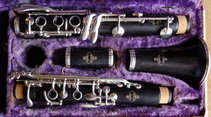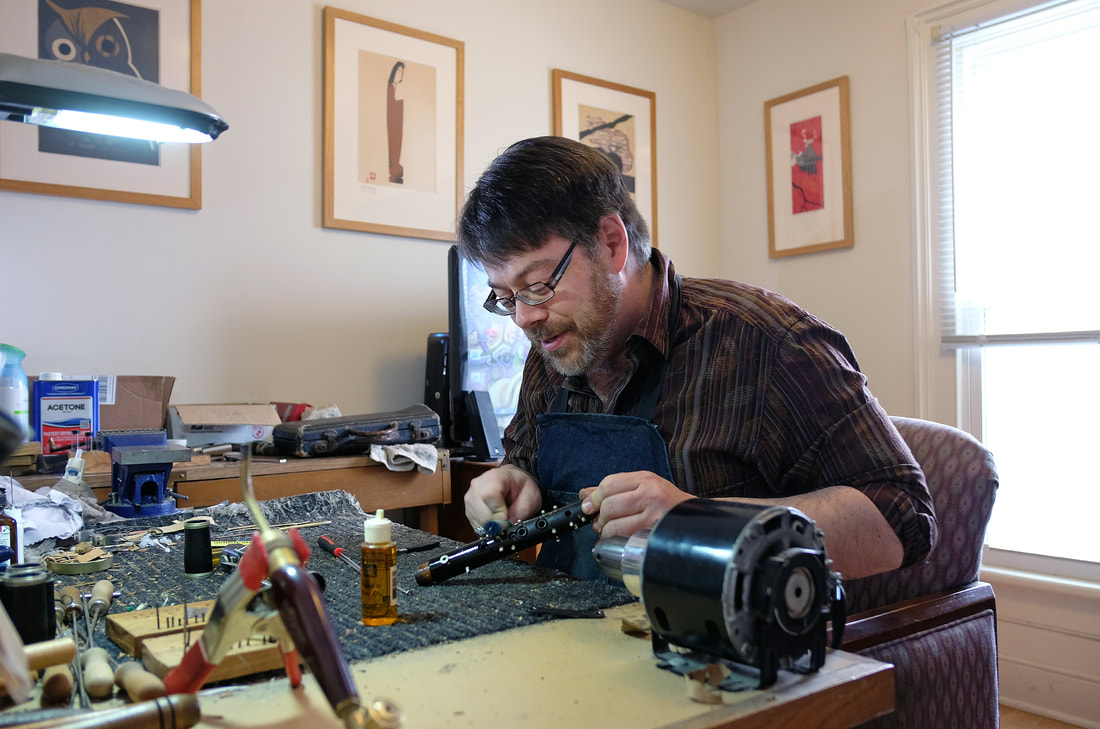|
To continue:
Yes, there are terrible metal and hard rubber clarinets out there: There are also hideous wood instruments, as anyone who has played a post WWII East German/ Soviet made horn with pot-metal keys can attest! However, the mitigating factors always seems to be quality of construction and attention to set-up rather than the material - I offer Tom Ridenour's pro line of Hard Rubber instruments, and vintage metal instruments by Noblet, H. Bettoney or Penzel Mueller as evidence. Tom's instruments have received a lot of kudos for pro quality detailing (like tone-hole undercutting) and, having discarded increasingly expensive and hard to find grenadilla, they are available for less than half the cost of the fabled R-13. I suspect the factors that initiated the sub-par reputation of a lot of better metal/hard rubber clarinets were: poor mouthpieces and shoddy pad work. If the mouthpieces that have come stock with a number of my acquisitions are anything to go by, Martin Frost at his best would be hard-pressed to draw good music from their narrow tips and uneven facing! Original pad-work shows signs of being equally hurried, in some cases, with cheap pads poorly seated and opening heights at the mercy of whatever cork was on sale that week. Now, take that same horn, overhaul it conscientiously with leather pads and attention to setup and play it with a decent mouthpiece and I suspect you will be pleasantly surprised! To be continued!
0 Comments
 Having just enjoyed a postprandial glass of wine, I'm going to take a chance on a topic I might not otherwise address: the ostensible primacy of grenadilla wood as the clarinet construction material of choice! Now, I know that I will probably ruffle some feathers with this, but I've played (and restored) a lot of clarinets in my day and have noticed a couple things: 1) the performer's mouthpiece, reed, oral cavity, articulation, breath support and tonal concept seem to have more to do with the resultant tone than a specific clarinet, and 2) the material from which the instrument is constructed plays less of a role in its tone than the quality of said construction plus setup and its interaction with all the factors mentioned in #1. The first point is fairly easy to establish in your own practice: if you play classical music, use a narrow tip, large chamber mouthpiece with a stiff, French file cut natural reed and are channeling Reginald Kell as your Tone God, you will have approximately the same dark, focused tone on a Buffet, Leblanc or Thibouville Freres. Likewise, if you play Jazz, use a Vandoren 5JB with a 2.5 Fibracell reed, and love Peanuts Hucko, the bright, flexible tone will shine out from an Orsi to an A. Robert. The ergonomics of key-work and the back-bore pressure will vary, it is true, along with other, subtler factors, but many of these are attributable to the quality of the pad work and the interaction of your mouthpiece with the bore size/taper of the instrument at hand. A change in mouthpiece or brand of reed would result in a more noticeable change of tone! The second can only be demonstrated with access to a number of instruments over time, which access most teachers and performers don't have, unless they are the kind of hardened collector who has the luxury of both copious funds and unencumbered hours. Being exactly that type myself, I have had the chance to play a variety of wood, hard rubber, metal, and composite clarinets in different keys and different fingering systems and believe that the material has a limited impact on the tone, intonation and play-ability of the instrument. To be continued....  For years, I used natural reeds on clarinet and saxophone. I tried different brands, different strengths, different cuts - all of which changed every time I changed mouthpieces, of course - and invested a lot of time and even more money in the pursuit of the 'perfect reed'. The conclusion I've come to is twofold : 'there isn't one' and 'if there were, it would be called Fibracell'! After years of throwing out 1/4 of the reeds in a box, or sanding and trimming to save stuffy, poorly cut or worn out reeds, I gave up and tried Rico Plasticovers. They are definitely brighter, longer lasting and more free-blowing, but I found grading inconsistent and had trouble with 'chirping'. I tried Bari clear plastic reeds and found them durable, but tone was monochromatic and they were best outdoors or in a situation where tone wasn't as important, like marching band. Finally, I found Fibracell. These are a resin/Mylar composite that look and feel very much like natural cane, but the resemblance ends there! They are durable, consistent, don't require soaking, don't get soggy, don't split, crack, warp or squeak and are more free-blowing (important for Jazz and Commercial players who want a brighter, more open sound) than cane. Each reed costs about $9, but will last for months. Many pros and teachers now use them, and I've had good feedback from students as well as improved tone and performance in my playing. There are a couple of mitigating factors that need to be taken into consideration, however: 1) they run a little softer than cane reeds, anywhere from 1/2 to a full grade. So, your tenor sax 2.5 will become a 3, and your clarinet 3 may become a 4. And 2) I find the stiffness ratio of tip to heart is a little different than cane, so intonation and articulation will have to be adapted accordingly. Regular practicing over a period of a couple weeks should make for a good transition; I wouldn't take one out for the first time on a gig! I know these are more popular with saxophonists than clarinetists, but I recommend them to anyone looking for a more consistent, free-blowing reed. Especially for doublers, they can't be beat! Buy a couple in different grades, try them for a couple weeks and see if you don't notice an improvement in your tone and intonation. Then, throw away all those half-full boxes of half playable reeds and don't look back..... I get asked for advice on this one frequently, and have a hard time coming up with a good answer! The reply I want to give is often "the one that sounds best for you" or "Practice an hour a day and you won't need a new mouthpiece". However, no one really wants to hear either of those, they want the perfect mouthpiece; it will be powerful, yet capable of great dynamics; in tune, but flexible; will blend but also cut through when needed...do you see where I'm going with this? If we could get all this from a $75 piece of hard rubber, we wouldn't have to practice!
There are some basic (and obvious) guidelines I can offer: if you want a dark, 'Classical' sound, use a more closed tip with a heavy reed, like a Vandoren M13 with a #4. If you want a brighter, more flexible sound, suitable for jazz or Klezmer, try a Bernard Portnoy 03 with a 2.5 Alexander, etc. The only problem with this is that there are a zillion mouthpieces out there and way too many brands of reeds! Not only will you have to crack open that piggy bank til it hurts but, as many folks don't seem to realize, your embouchure changes with every mouthpiece change you make. For the first couple days, all you notice is the difference: "Wow, what tone/high range/flexibility", you think. Then, a strange thing happens - you start to sound less like the mouthpiece and more like yourself! Your embouchure is adapting to the change and you are starting to slide back into the problems/habits that made you look for a new mouthpiece in the first place. So, if you possess a good instrument in good repair and you already practice regularly but are dissatisfied with your sound and want to make a change, try this: buy a bunch of the Rico Royal Graftonite mouthpieces and be scientific about it - they only cost about $16 each on Amazon, so you won't go broke. The 'A' has a large chamber for a darker tone, the 'B' a medium chamber for a more middle of the road tone, and the 'C' has a smaller chamber for a brighter sound. They also have 3 tips: the 3 (more closed facing with a shorter lay), the 5 (medium facing and medium lay) and the 7 (open facing with a longer lay). I'd stick with the A and B, unless you really covet a bright sound. Try the different facings with a good, middle of the road reed, like a #3 VanDoren bluebox, and see what you like, playing each for at least a few days so you can distinguish between the sound of the mouthpiece and your sound WITH the mouthpiece. You might be pretty well satisfied with a Rico, as they are well designed and material doesn't matter much as people would like you to believe. On the other hand, you could take note of the measurements and look for a 'better' hard rubber mouthpiece of similar playing characteristics. Selmer, Vandoren, Portnoy, Hawkins, and many more are excellent pieces. Myself, I use a Rico B7 with a Fibracell reed (I know, I can hear the classical players out there shuddering). I get a sound that I like and the reeds require no soaking, scraping or other maintenance. So, next time I'll talk about reeds.... |
Archives
February 2024
AuthorThe Licorice Shtick Blog is the creation of the Vintage Clarinet Doctor, a Winston Salem, NC based woodwind instrument repair shop specializing in vintage and antique clarinets, saxophones, and the occasional flute. Categories |

 RSS Feed
RSS Feed